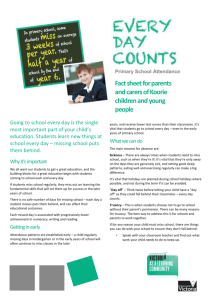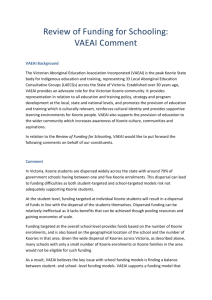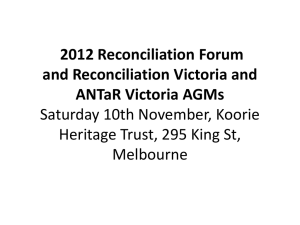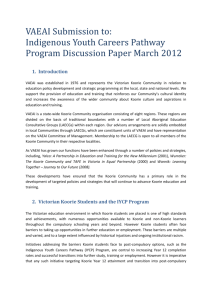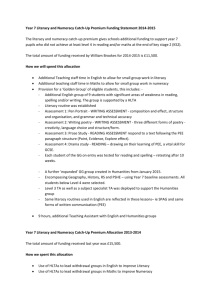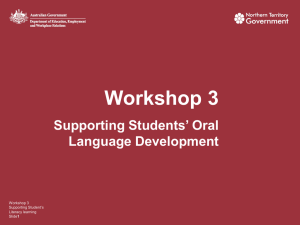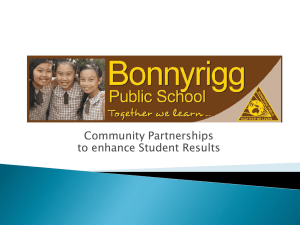Early Years Koorie Literacy and Numeracy Program
advertisement
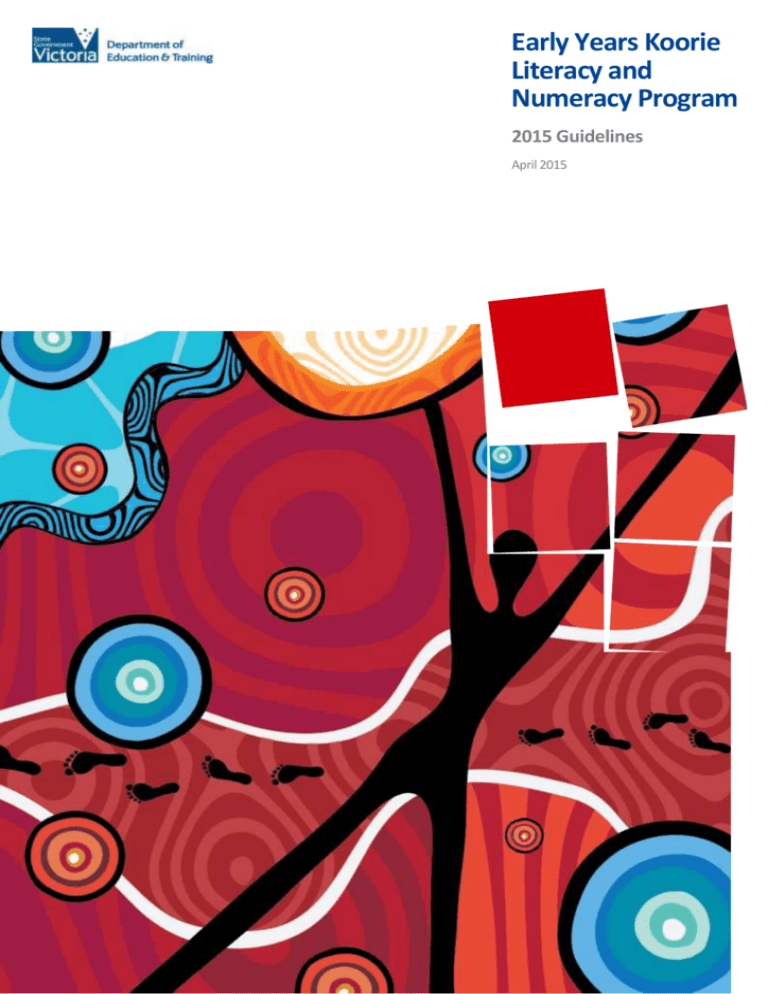
Early Years Koorie Literacy and Numeracy Program 2015 Guidelines April 2015 Published by the Department of Education and Training Melbourne 24 April 2015 © State of Victoria (Department of Education and Training) The copyright in this document is owned by the State of Victoria (Department of Education and Training), or in the case of some materials, by third parties (third party materials). No part may be reproduced by any process except in accordance with the provisions of the Copyright Act 1968 the National Education Access Licence for Schools (NEALS) (see below) or with permission. NEALS is an educational institution situated in Australia which is not conducted for profit, or a body responsible for administering such an institution may copy and communicate the materials, other than third party materials, for the educational purposes of the institution. Authorised by the Department of Education and Training, 2 Treasury Place, East Melbourne, Victoria, 3002. This document is also available on the internet at http://education.vic.gov.au/about/programs/aboriginal/Pages/earlyliteracynu meracy.aspx Artwork Artwork in this document is adapted from original artwork below by Dixon Patten. Dixon is an Aboriginal person from the Yorta Yorta peoples (Murray River) and Gunnai peoples (Gippsland area) of Victoria. Dixon is a freelance graphic designer and uses a new age digital medium (computer art) that is contemporary, organic and yet, Aboriginal. Contact: dixonpatten@gmail.com Throughout this document, the term ‘Koorie’ refers to both Aboriginal and Torres Strait Islander people. The terms ‘Aboriginal’ and ‘Indigenous’ have been used when they are part of a title or text drawn from a published source. Both terms are used inclusively of Aboriginal and Torres Strait Islander people. Building strong foundations Contents in literacy and numeracy for Koorie students in the early years of their schooling Introduction 5 Background 5 Evidence base for an early years focus 5 The Victorian context 6 Student achievement 2014 7 Funding 8 Funding model 8 Allocation and management of funds 8 Use of EYKLNP funds 9 Accountability Planning 10 11 Effective interventions 11 Family engagement 11 Individual Education Plans (IEPs) 11 Key considerations 12 Attendance 13 A note on curriculum content and pedagogy 14 Contacts and further information 15 Website 15 Koorie Education Workforce 15 Koorie Unit 15 Appendices 16 Appendix 1: Sample letter to parents 16 Appendix 2: Recruiting personnel – regulatory requirements 17 Appendix 3: Snapshot of the 2014 EYKLNP 18 Appendix 4: Student achievement in 2014 19 Introduction Background The Early Years Koorie Literacy and Numeracy Program (EYKLNP) was introduced in 2014 to support improved literacy and numeracy outcomes for Years Prep–3 Koorie students in Victorian government schools. “Positive school outcomes are more likely to occur when Indigenous young people have positive conceptions of themselves as Indigenous people and as students” The goal of the EYKLNP program is that by Year 3, all Koorie students will have established firm foundations in literacy and numeracy as the basis for successful learning in future years. Positive learning environments for Indigenous children and young people. Closing the Gap Clearinghouse, 2014 The EYKLNP also supports the broader aspiration for all Koorie students to have a strong sense of cultural identity and self-efficacy1 as learners. Student achievement data from 2014 EYKLNP schools (see page 8) indicates that achieving the goal of the EYKLNP will require focused and sustained efforts from schools. Funding in 2015 will support these efforts by supplementing existing whole school provision to assist schools to implement culturally informed and effective early interventions for Prep–3 Koorie students. Evidence base for an early years focus Considerable evidence acquired over the last decade shows that the early years of schooling coincide with a period of rapid development, which lays the foundation for future life chances. There is also strong evidence regarding the disparity in literacy and numeracy outcomes between Indigenous and nonIndigenous students in the early years of school as follows: English Online Interview data indicates that Koorie students enter school with lower English language levels (as measured by Interview items) than non-Koorie students. In 2014, National Minimum Standards for Year 3 in Reading and Numeracy were met by 85.3 percent and 88.5 precent of Indigenous students respectively, compared to 95 percent and 95.8 percent of non-Indigenous students. Despite yearly fluctuations, a significant achievement gap between Year 3 Indigenous and non Indigenous students in NAPLAN Reading and Numeracy persists as shown in Figure 1. This gap widens as students progress to higher levels of schooling. Figure 1: Achievement gap between Indigenous and non-Indigenous students – Year 3 NAPLAN 2010-2014 Year 3 Reading Gap 10 10.6 8.9 8.9 9.7 7.5 8 6 4 2 0 12 Percentage points Percentage points 12 Year 3 Numeracy Gap 10 10 9.4 7 8 7.8 7.3 2013 2014 6 4 2 0 2010 2011 2012 2013 2014 2010 2011 2012 1 Self-efficacy refers to students’ sense of self-belief in themselves as successful learners. Students with strong self-efficacy believe they can accomplish even difficult tasks and increase their efforts in the face of failure. Students who do not believe they can be successful tend to avoid difficult tasks and are more likely to give up in the face of difficulty or failure. Early Years Koorie Literacy and Numeracy Program 2015 | Page 5 The Victorian context The Victorian Aboriginal Affairs Framework (VAAF) 2014– 2018 outlines targets and strategies for developing strong social, cultural and economic foundations for current and future generations of Aboriginal Victorians. Under Education and Training, the VAAF notes the target to halve the gap2 in reading, writing and numeracy by 2018. The EYKLNP supports the Victorian government’s commitment to this target. “... closing the gap requires a long term commitment to achieve generational change.” Victorian Aboriginal Affairs Framework 2013–18 In 2015, implementation of the EYKLP will occur in the broader context of Victoria’s ongoing commitment to system-wide improvement to ensure all services are inclusive of, and targeted to the needs of Koorie children, young people and adults. Seven key, mutually reinforcing elements have been identified as fundamental foundations of this system-wide improvement. School cultures and practices which reflect these foundational elements will be best placed to ensure that the strategies used to improve achievement and engagement of all students will be effective in improving the outcomes for Koorie students. The seven foundational elements are outlined in Table 1. Table 1: Foundations for system-wide improvements in delivering enhanced outcomes for Koorie people Committed and courageous leadership Principals and school leaders lead and drive inclusiveness and improved outcomes for Koorie students in partnership with their local communities Respect and recognition Respect and recognition of Koorie people, history and culture is promoted in everyday school practice and curriculum Culturally accessible and responsive services School environments are inclusive, engaging and welcoming of Koorie people to promote greater understanding, confidence and trust between the school and the Koorie community. Strong and resilient families Schools support the role of Koorie parents as first teachers and as guardians for their children’s wellbeing and safety A skilled workforce to facilitate change Schools develop the capacity of both the general workforce and the dedicated Koorie workforce to support greater inclusivity and improved outcomes for Koorie students and families. Partnerships and connectivity at the local level Schools collaborate and engage with Koorie communities and local agencies to support vulnerable or at risk Koorie students Robust accountability Schools accept accountability for Koorie student outcomes. 2 The gap refers to the difference in educational achievement between Indigenous and non-Indigenous students measured by NAPLAN. In 2008, the Council of Australian Governments (COAG) set a target to halve the gap in reading, writing and numeracy by 2018. Early Years Koorie Literacy and Numeracy Program 2015 | Page 6 Student achievement 2014 Baseline data Schools used a wide range of assessment tools and methods to determine student needs and measure student progress. As part of their 2014 program accountabilities, schools submitted pre and postintervention achievement data for supported students. The data provide a broad snapshot of achievement of supported students and a baseline against which future success of the EYKLNP can be measured. 3 A measure of progress towards the goal of the EYKLNP will be the change over time in the percentage of supported students who achieve expected levels. Schools provided assessment data for 1,405 students in Reading and for 1,117 students in Number and Algebra. The data are summarised in Figure 2. Further details on student achievement are provided in Appendix 4. Figure 2: EYKLNP-supported students at or above expected level (post-intervention) Reading (AusVELS) 60% 50% 48% 40% 40% 39% 28% 30% 20% 10% 0% Prep (419) Year 1 (351) Year 2 (313) Year 3 (419) Year level and number of students Number and Algebra (AusVELS) 70% 60% 57% 47% 50% 41% 40% 30% 22% 20% 10% 0% Prep (308) Year 1 (287) Year 2 (260) Year 3 (308) Year level and number of students 3 Many schools noted that progress made by supported students was not always reflected in their AusVELS scores. AusVELS data is used for system level evaluation since it is used by all schools for all students to provide a broad indication of student achievement in relation to expected level. Early Years Koorie Literacy and Numeracy Program 2015 | Page 7 Funding Funding model A total of $2 million per annum is available for the EYKLNP. The amount of funding provided to individual schools is dependent on the number of eligible students identified. In response to feedback from schools, a new funding model is being implemented in 2015. The funding criteria for the new model are outlined below. Funding criteria In special schools, eligibility for EYKLNP is determined by the age of Koorie students. All Koorie students who were born between 1 January 2006 and 30 April 2010 will receive funding. For all other schools, funding criteria have been chosen to serve as proxies for the literacy and/or numeracy achievement of P–3 Koorie students enrolled in 2015. The criteria provide the basis for determining relative student need across all schools for funding purposes. The criteria are as follows: Proxies for literacy and numeracy achievement are used as a basis for distribution of funds to schools. Prep Koorie students assessed as below expected level in Listening and Speaking using the 2015 English Online Interview. Years 1-3 Koorie students assessed as below expected level in AusVELS Reading and/or Number and Algebra at the end of 2014. Since the criteria above draw on a subset only of all literacy and numeracy skills, not every P–3 Koorie student who is below the expected level in any aspect of literacy and/or numeracy will be identified. Based on local knowledge schools may use their allocated funding to support additional Koorie students where appropriate. Allocation and management of funds Activating funds Funding to schools will be calculated centrally – schools do not need to submit data for this purpose. Eligible schools will be informed of their funding in Term 2, 2015 and will be required to submit a brief online Program Initiation Report (PIR) by 29 May to activate their funding. Further information will be provided to schools via the DET School Update. Managing funds Schools are expected to retain appropriate financial records relating to the administration of funding for the EYKLNP. Following submission of the Program Initiation Report, the 2015 EYKLNP allocation will be transferred to the school’s high yield account and appropriately tagged. Funding should be receipted into CASES21 using GL code 70080 (Other Department Grants) and Sub-Program code 9623 (Early Yrs Koorie Lit & Num Prg). Managing student movement EYKLNP funding is based on preliminary February 2015 census data for P–3 Koorie students enrolled in Victorian government schools. If an eligible student funded through the EYKLNP transfers to another government school, the transferring school should transfer funds as appropriate. If a student leaves a school and the destination is unknown, the school may re-direct funds to support other P–3 Koorie students if required, or contact the program coordinator to return the funds. Early Years Koorie Literacy and Numeracy Program 2015 | Page 8 Use of EYKLNP funds EYKLNP funding supplements whole school literacy and numeracy provision. Funding is intended to assist schools to accelerate the literacy and/or numeracy learning of P-3 Koorie students by providing individualised and culturally informed interventions that target the specific needs of identified students. “The importance of having an experienced teacher in this role cannot be underestimated.” EYKLNP Principal Recruiting additional personnel EYKLNP funded schools are encouraged to engage additional personnel in ways that ensure eligible Koorie students receive high quality, targeted support by appropriately qualified personnel. Additional personnel may: work directly with identified Koorie students provide support in the classroom (e.g. during a literacy block) so that the teacher can provide additional focussed support to eligible Koorie students; release an ‘expert teacher’ from classroom duties to provide a liteacy/numeracy support program for eligible Koorie students. Schools may choose to form clusters to share a tutor. Payment and travel arrangements in these circumstances may be negotiated between the schools and the tutor. Additional personnel must demonstrate high-level knowledge and skills in literacy and/or numeracy teaching and learning. This includes skills in the use of assessment and teaching strategies to engage, motivate and accelerate the progress of students identified for support. Tutors and teachers also need to understand and be culturally sensitive to the diverse needs of Koorie students and their families and be able to build productive working relationships with Koorie students and their families. For information on regulatory requirements, awards and conditions see Appendix 2. Building family capacity Schools are encouraged to explore strategies for enhancing the conditions for literacy/numeracy learning for Koorie students outside of school. For example, where appropriate, a portion of funds could be directed to providing a family literacy program to build the capacity of Koorie student families to support their child/children with literacy and numeracy skills development in the home. Early Years Koorie Literacy and Numeracy Program 2015 | Page 9 Unacceptable use of funding The EYKLNP funding should not be used to implement strategies which are required of all schools or which are part of normal curriculum provision for all students. EYKLNP funding should not be used for: purchasing resources, or equipment, including digital devices; employment of staff to reduce general class sizes; interventions which are not primarily focused on literacy and numeracy, for example developing wellbeing or self-esteem programs; and/or camps, travel expenses, accommodation, clothing and excursions. Accountability Reporting Schools funded by the EYKLNP are required to provide pre and post-intervention AusVELS assessment data in Reading and Number and Algebra to support program evaluation and monitor progress towards state-wide improvement of Koorie student achievement. Advice about the process for submitting data will be provided by the start of Term 4, 2015. A snapshot of the data required is provided in Figure 3. Figure 3: Sample EYKLNP program evaluation data Early Years Koorie Literacy and Numeracy Program 2015 | Page 10 Planning Schools will need to identify which Koorie students will receive additional support, set appropriate learning goals and plan interventions according to individual student needs and learning dispositions. Effective interventions “We value fluid groupings of students, where children move in and out of small groups depending upon their needs. The interventions that worked the best were therefore changing regularly.” EYKLNP Principal The Australian Council of Educational Research (ACER) has identified the common characteristics underpinning the design of effective interventions for literacy and numeracy in the early years of schooling 4 . Effective interventions are: are embedded in a whole school approach; employ early diagnosis of literacy and numeracy difficulties; focus on key aspects of literacy and numeracy development; use individualised approaches; and incorporate evidence-based principles for effective literacy and numeracy teaching. Schools should ensure that EYKLNP funded interventions share these characteristics. Family engagement Evidence shows that the most effective outcomes for all students are achieved when teachers and schools engage with students and their families in a partnership focused on improving outcomes. Schools need to be mindful of the possible impact that being ‘singled out’ for support may have on some Koorie students or their families and discuss support options with students and their families. The Koorie Education Workforce (see p. 15) may facilitate engagement with students’ families and assist schools to better understand the cultural, linguistic and family backgrounds of their Koorie students. Where students are entering school for the first time, schools should source additional information through relevant documents such as the Transition Statements from Early Childhood Education Providers or reports from students’ previous schools to inform intervention support. Individual Education Plans (IEPs) Success criteria: - Set high expectations - Build on strengths Schools providing EYKLNP interventions are expected to inform families and invite them to be involved in developing students’ Individual Education Plan (IEP). A sample letter is provided in Appendix 1. Effective IEPs will be based on the expectation that all Koorie students can achieve high standards if provided with the right learning conditions and support. Effective IEPs will typically describe: - Set achievable goals students’ strengths, abilities and learning dispositions; - Celebrate success challenging but achievable learning goals; - Involve family strategies for achieving the learning goals; measures of progress; and means for involving the student’s family. 4 Meiers, Marion; Reid, Kate; McKenzie, Phil; and Mellor, Suzanne, "Literacy and numeracy interventions in the early years of schooling : a literature review : report to the Ministerial Advisory Group on Literacy and Numeracy" (2013). http://research.acer.edu.au/policy_analysis_misc/20 Early Years Koorie Literacy and Numeracy Program 2015 | Page 11 Key considerations Schools identified a range of factors which influenced the success of EYKLNP funded interventions. The considerations, comments and questions below may inform schools’ planning in 2015 to ensure that interventions have the characteristics most likely to lead to success. “The classroom teacher … can offer the most expertise and support. Education Support staff work with the other students to allow the teacher more focussed 1 to 1 and small group time with the (supported) students. “ EYKLNP Principal Consideration School comment Question Expertise “The importance of having an experienced teacher in this role cannot be underestimated.” Who will provide support? “.. we value fluid groupings of students, where children move in and out of small groups depending upon their needs. The interventions that worked the best were therefore changing regularly.” Are approaches flexible and adaptable to changing student needs? Models of support Will support be provided by personnel with the appropriate level expertise? What changes can be made if students are not making appropriate progress? “Small groups were often cross class and cross year groups, depending on the student's needs.” Discretion Expectations “Some Koorie students do not want the additional attention. Programs that deliver a certain level of discretion … seem to work the best.” What is the student preference for support? “The learning intention and success criteria were clear to the students and were referred to for regular feedback.” Are expectations and learning intentions clear and appropriate? Has the support model been discussed with student and/or parent? Are expectations and learning goals challenging? Are goals achievable? How is success measured? Confidence and selfefficacy “Perhaps the most significant aspect … has been the development of relationships and the fostering of self-esteem. These have led to our children developing the feeling that they can achieve at school". How is success celebrated? How are students supported to take risks? How is self-efficacy5 strengthened? “His learning … was often only hindered by his confidence in the next challenge. [He] prefers to read at a level that is easy and loses confidence when he is aware of a challenge.” 5 For explanation of self-efficacy see note on page 5. Early Years Koorie Literacy and Numeracy Program 2015 | Page 12 Attendance “In general, schools have little control over the background and life experiences of Indigenous students. (However) there is growing recognition in the literature that the school context plays a more important role in improving attendance and therefore engagement of Indigenous students than family background, and that schools can play a role in reducing the impacts of social background.” Positive learning environments for Indigenous children and young people. Closing the Gap Clearinghouse, 2014 Many EYKLNP schools commented on the impact of attendance on the educational outcomes of Koorie students and cited influences that were out of the control of the school. Some schools commented that the EYKLNP program had had a positive impact on student attendance and had increased students’ sense of connectedness to school and improved relationships with students’ families. A wide range of factors may influence student attendance as depicted in Figure 4. Schools can influence some of these factors. “There has been improvement in attendance with specified students developing a stronger connectedness with their learning at school.” EYKLNP Principal Schools are encouraged to reflect on the factors which may affect the attendance of specific students and consider changes or adjustments which will foster a learning environment where Indigenous students want to attend, learn and succeed. Figure 4: Factors impacting on attendance6 6 What Works. The Work Program: Core Issue 5 - Student engagement (page 6). www.whatworks.edu.au Early Years Koorie Literacy and Numeracy Program 2015 | Page 13 A note on curriculum content and pedagogy Learning about, respecting and valuing the place of First Nations people enhances all Victorian children’s sense of place in the community. A culturally inclusive curriculum also contributes to improved literacy and numeracy outcomes for Koorie students by fostering a strong sense of cultural identity and pride in their connection with the world’s oldest living cultures. The Victorian Early Years Learning and Development Framework The Victorian Early Years Learning and Development Framework (VEYLDF) recognises and respects Aboriginal cultures and the unique place of these in Victoria’s heritage and future. It acknowledges that children’s learning and development is enhanced by learning about, valuing and respecting cultural diversity and different ways of knowing and being. The VEYLDF provides all schools with a framework for advancing the learning and development of all children from birth to eight years. It outlines Learning and Development Outcomes aligned to AusVELS and Practice Principles to support the delivery of effective learning and development experiences relevant to children in their local context. Schools funded by the EYKLNP are encouraged to use the VCAA’s Online Illustrative Maps7 to support the design of experiences and opportunities that connect AusVELS to the Learning and Development Outcomes of the Victorian Early Years Learning and Development Framework. Aboriginal and Torres Strait Islander History and Cultures priority When planning whole school curriculum, schools funded through the EYKLNP are encouraged to consider the opportunities afforded by the Aboriginal and Torres Strait Islander History and Culture priority in the Australian Curriculum. The priority is organised through the interconnected aspects of Country/Place, People and Culture and is included in the Australian Curriculum to ensure all students connect their learning with this important issue in contemporary society. Content descriptors which link to the priority are indicated by an icon. Further advice is provided in the elaborations. 7 http://www.vcaa.vic.edu.au/Pages/earlyyears/vfldoutcomes/index.aspx Early Years Koorie Literacy and Numeracy Program 2015 | Page 14 Contacts and further information Website These guidelines and further information are available on the EYKLNP website at: http://education.vic.gov.au/about/programs/aboriginal/Pages/earlyliteracynumeracy.aspx. Koorie Education Workforce The Koorie Education Workforce (KEW) comprises regionally based Koorie Education Coordinators (KECs) and Koorie Engagement Support Officers (KESOs) that can assist schools by supporting and facilitating engagement with students’ families. Schools are advised to contact their regional office for assistance from the KEW. Region Phone Number North–Eastern Victoria Benalla 03 5761 2100 Glen Waverley 03 9265 2400 Bendigo 03 5440 3111 Coburg 03 9488 9488 Dandenong 03 8765 5600 Moe 03 5127 0400 Ballarat 03 5337 8444 West Footscray 03 9291 6500 Geelong 03 5225 1000 North–Western Victoria South–Eastern Victoria South–Western Victoria Koorie Unit For all central enquiries and information about the EYKLNP, please contact the program coordinator Clyde Juriansz, Koorie Unit, Priority Cohorts Branch, Secondary Reform, Transitions and Priority Cohorts Division, DET. Email: juriansz.clyde.h@edumail.vic.gov.au Phone: 9637 3529 Mail: EYKLNP Coordinator Koorie Unit, Priority Cohorts Branch Secondary Reform, Transitions and Priority Cohorts Division Department of Education and Training Level 2, 33 St Andrews Place East Melbourne, 3002 Early Years Koorie Literacy and Numeracy Program 2015 | Page 15 Appendices Appendix 1: Sample letter to parents The example letter will need to be adapted according to the nature of the support provided by the school. Dear [insert name of parent/guardian], I am writing to inform you about the 2015 Early Years Koorie Literacy and Numeracy Program (EYKLNP) which is available to support your child [insert name] with [his/her] literacy and/or numeracy learning. The EYKLNP is part of the Department of Education and Training’s commitment to assist and support Koorie children with their learning and to engage students’ families in this process. The program is available to Koorie students in Years P-3 who need assistance with literacy and/or numeracy and aims to improve the achievement of these students in these areas. Our school has received funding to conduct this program in 2015 and your child [student’s name] is eligible to receive additional support based on assessment of [his/her] literacy/numeracy skills. The program will be conducted during school hours and may involve one-on-one support, group work or a combination of these approaches based on how [student’s name] learns best. The type of support provided will be guided by [student name]’s Individual Education Plan. Please feel free to contact me on [phone number] to arrange a meeting or if you have further enquiries. Yours sincerely Principal School Page 16 Appendix 2: Recruiting personnel – regulatory requirements The school is responsible for all matters relating to the engagement and subsequent payment for additional personnel consistent with the Working with Children Act 2005 and the requirements of the Victorian Institute of Teaching. Schools need to ensure that payments accord with appropriate awards and conditions, and for meeting all superannuation and PAYG tax deduction requirements. It is recommended that agreement is reached in writing regarding payment prior to commencing engagement. Where schools use EYKLNP funding to recruit personnel as tutors who work directly with students the school must ensure: the tutor is qualified (i.e. a teacher registered with the Victorian Institute of Teaching); or if the tutor is not a registered teacher, they must provide evidence to the school that they have the skills and knowledge to provide the level of tutoring support required. if the tutor is not a qualified teacher registered with the Victorian Institute of Teaching, they must hold a current Working with Children Check. The Working with Children Act 2005 requires that people who work or volunteer in certain child-related work apply for, and pass, a Working with Children Check. the tutor understands and is culturally sensitive to the diverse needs of Koorie students and their families there is no conflict of interest in using the tutor. Teachers and members of the Koorie Education Workforce currently employed by DET cannot receive additional payments for tutoring. For further information on awards and conditions see: Salary Rates: http://www.education.vic.gov.au/hrweb/employcond/Pages/salaries.aspx Victorian Government Schools Agreement 2013: http://www.education.vic.gov.au/hrweb/Documents/VGSA-2013.pdf Victorian Government Schools Agreement 2013 Power Point presentation: http://www.education.vic.gov.au/hrweb/Documents/VGSA-2013-Presentation.pptx Page 17 Appendix 3: Snapshot of the 2014 EYKLNP In 2014, there were 3,991 Koorie students in Years P–3 in 820 Victorian government schools. EYKLNP funding was provided to 321 schools. These funded schools comprised 2,661 P–3 Koorie students, representing 67 percent of the total 2014 Prep-Year 3 Koorie cohort. Program Initiation data from 2014 funded schools indicated that 1,850 of the 2,661 P-3 Koorie students in funded schools (70 per cent) were provided with additional support. The data are summarised in below. Table 2: Schools and students with P-3 Koorie cohorts in 2014 All schools EYKLNP schools Proportion Schools with P-3 Koorie cohorts 820 321 39% P-3 Koorie students 3991 2661 67% Table 3: Koorie students supported by the EYKLNP in 2014 P-3 Koorie students EYKLNP supported students All schools 3991 1850 46% EYKLNP schools 2661 1850 70% A dispersed Koorie student population Of the 321 EYKLNP funded schools in 2014: 266 schools (83 percent) had P–3 Koorie cohorts between 1 and 12 students with an average P-3 Koorie cohort size of 5. These schools accounted for 1,291 students (49 percent of P–3 Koorie students in funded schools). In the majority of funded schools, the average size of the P-3 Koorie cohort was 5 students, but in a small number of schools the average P-3 Koorie cohort size was 46 students. 42 schools (13 percent) had P-3 Koorie cohorts between 13 and 30 students with an average cohort size of 18. These schools accounted for 771 students (29 percent of P–3 Koorie students in funded schools). 13 schools (4 percent) had P–3 Koorie cohorts of over 30 students with an average cohort size of 46. These schools accounted for 599 students (23 percent of P–3 Koorie students in funded schools). The number of schools with small, medium and large P–3 Koorie cohorts (as described above), and the corresponding number of students are depicted in Figure 5. Figure 5: P-3 Koorie student cohort size – number schools and number of students P-3 Koorie students in EYKLNP schools with different P-3 Koorie cohorts EYKLNP funded schools with different P-3 Koorie cohort sizes 1400 1291 1200 1000 42 266 771 800 599 600 13 400 200 0 Small (1-12, avg=5) Meduim (13-30, avg=18) Small (1-12, avg=5) Meduim (13-30, avg=18) Large (>30, avg=46) Large (>30, avg=46) Page 18 Appendix 4: Student achievement in 2014 Reading Figure 6 and Figure 7 provide a summary and details of student achievement in Reading for students supported by EYKLNP funding in 2014. Blue bars indicate achievement at or above expected level. Figure 6: EYKLNP supported Koorie students at or above expected level (post intervention) in AusVELS Reading 60% 48% 50% 40% 39% 40% 28% 30% 20% 10% 0% Prep (419) Year 1 (351) Year 2 (313) Year 3 (419) Year level and number of students Figure 7: Post intervention AusVELS Reading scores for EYKLNP supported Koorie students Prep Year 1 45% 35% 40% 40% 29% 25% 30% 19% 20% 25% 20% 28% 30% 35% 35% 17% 15% 15% 11% 8.5% 10% 10% 5% 2% 5% 5% 2% 2.0% 0.2% 0% 0% 0% 0% 0% 0% 0.3% 0% 0% 0% 0% 0 0.5 F F.5 1 1.5 2 2.5 3 3.5 4 0 0.5 F Expected level F.5 1 1.5 2 2.5 3 3.5 4 Expected level Year 2 Year 3 35% 28% 30% 31% 30% 25% 25% 25% 19% 20% 19.6% 20% 21.1% 15% 15% 10% 10% 5% 10.9% 12% 4% 7% 6% 5% 2% 1% 5% 0.3% 0% 0% 4% 1% 1% 1% 3% 1% 0% 0 0.5 F F.5 1 1.5 2 2.5 3 3.5 4 Expected level 0 0.5 F F.5 1 1.5 2 2.5 3 3.5 4 Expected level Page 19 Number and Algebra Figure 8 and Figure 9 provide a summary and details of student achievement in Number and Algebra for students supported by EYKLNP funding in 2014. Blue bars indicate achievement at or above expected level. Figure 8: EYKLNP supported Koorie students at or above expected level (post intervention) in AusVELS Number and Algebra 70% 57% 60% 47% 50% 41% 40% 30% 22% 20% 10% 0% Prep (308) Year 1 (287) Year 2 (260) Year 3 (308) Year level and number of students Figure 9. Post intervention AusVELS Number and Algebra scores for EYKLNP supported Koorie students Prep Year 1 50% 45% 45% 45% 40% 35% 34% 35% 29% 30% 30% 25% 25% 20% 20% 16% 15% 15% 10% 39% 40% 9% 8% 10% 2% 5% 0.3% 0% 0% 0% 0% 0% 0% 5% 7% 6.3% 1.4% 0.3% 0% 0 0.5 F F.5 1 1.5 2 2.5 3 3.5 4 0 0.5 F Expected level F.5 1 1.5 2 2.5 3 3.5 4 Expected level Year 2 Year 3 40% 35% 32% 34.6% 35% 27.9% 30% 30% 25% 25.8% 25% 19% 20% 18% 20% 15% 15% 10.3% 10% 8% 10% 5% 0% 0% 0% 0% 1% 2% 5% 3% 1% 0.4% 0% 0% 5% 3% 3% 1% 0% 0% 2% 0% 0% 0 0.5 F F.5 1 1.5 2 2.5 3 3.5 4 Expected level 0 0.5 F F.5 1 1.5 2 2.5 3 3.5 4 Expected level Page 20 Page 21
